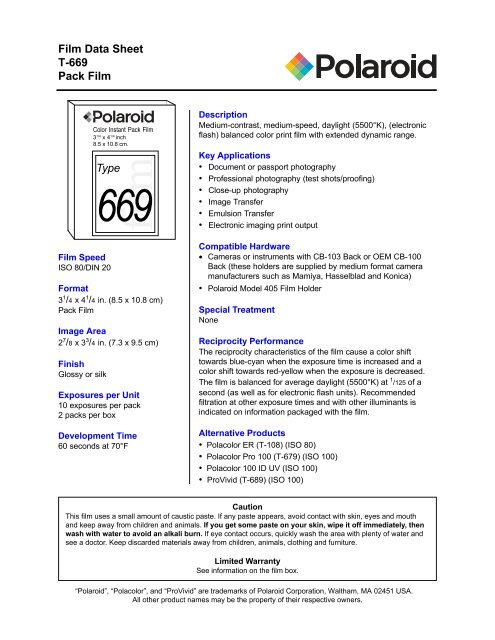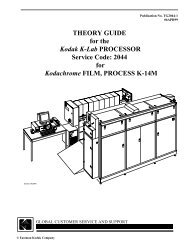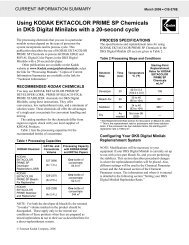Polaroid Type 669 - Stephen Grote
Polaroid Type 669 - Stephen Grote
Polaroid Type 669 - Stephen Grote
You also want an ePaper? Increase the reach of your titles
YUMPU automatically turns print PDFs into web optimized ePapers that Google loves.
Film Data Sheet<br />
T-<strong>669</strong><br />
Pack Film<br />
Film Speed<br />
ISO 80/DIN 20<br />
Format<br />
3 1 /4 x 4 1 /4 in. (8.5 x 10.8 cm)<br />
Pack Film<br />
Image Area<br />
2 7 /8 x 3 3 /4 in. (7.3 x 9.5 cm)<br />
Finish<br />
Glossy or silk<br />
<br />
<br />
<br />
<br />
<br />
<br />
Exposures per Unit<br />
10 exposures per pack<br />
2 packs per box<br />
Development Time<br />
60 seconds at 70°F<br />
Description<br />
Medium-contrast, medium-speed, daylight (5500°K), (electronic<br />
flash) balanced color print film with extended dynamic range.<br />
Key Applications<br />
• Document or passport photography<br />
• Professional photography (test shots/proofing)<br />
• Close-up photography<br />
• Image Transfer<br />
• Emulsion Transfer<br />
• Electronic imaging print output<br />
Compatible Hardware<br />
• Cameras or instruments with CB-103 Back or OEM CB-100<br />
Back (these holders are supplied by medium format camera<br />
manufacturers such as Mamiya, Hasselblad and Konica)<br />
• <strong>Polaroid</strong> Model 405 Film Holder<br />
Special Treatment<br />
None<br />
Reciprocity Performance<br />
The reciprocity characteristics of the film cause a color shift<br />
towards blue-cyan when the exposure time is increased and a<br />
color shift towards red-yellow when the exposure is decreased.<br />
The film is balanced for average daylight (5500°K) at 1 /125 of a<br />
second (as well as for electronic flash units). Recommended<br />
filtration at other exposure times and with other illuminants is<br />
indicated on information packaged with the film.<br />
Alternative Products<br />
• Polacolor ER (T-108) (ISO 80)<br />
• Polacolor Pro 100 (T-679) (ISO 100)<br />
• Polacolor 100 ID UV (ISO 100)<br />
• ProVivid (T-689) (ISO 100)<br />
Caution<br />
This film uses a small amount of caustic paste. If any paste appears, avoid contact with skin, eyes and mouth<br />
and keep away from children and animals. If you get some paste on your skin, wipe it off immediately, then<br />
wash with water to avoid an alkali burn. If eye contact occurs, quickly wash the area with plenty of water and<br />
see a doctor. Keep discarded materials away from children, animals, clothing and furniture.<br />
Limited Warranty<br />
See information on the film box.<br />
“<strong>Polaroid</strong>”, “Polacolor”, and “ProVivid” are trademarks of <strong>Polaroid</strong> Corporation, Waltham, MA 02451 USA.<br />
All other product names may be the property of their respective owners.
Film Data Sheet<br />
Technical Data<br />
T-88, T-108, T-<strong>669</strong> and T-<strong>669</strong>S (pack); T-559 and<br />
T-559S (4x5 pack); T-59 (4x5 sheet) and T-809<br />
(8x10 sheet) Instant Color Peel-Apart Films<br />
The information in this data sheet<br />
represents the typical performance<br />
of <strong>Polaroid</strong>’s T-88, T-108, T-<strong>669</strong>,<br />
T-<strong>669</strong>S, T-559, T-559S, T-59 and<br />
T-809 color films. Specific film lots<br />
may vary.<br />
Recommended<br />
speed (ISO)<br />
Recommended<br />
processing time<br />
and<br />
temperature<br />
Resolution<br />
(1000:1)<br />
Processing time and temperature<br />
For best results process at temperatures<br />
above 60 o F(16 o C).<br />
o F<br />
o C<br />
Time in<br />
seconds<br />
80 / 20 o<br />
60 sec. at<br />
70 o F/21 o C<br />
9 line pairs/mm<br />
Contrast medium<br />
D-Max: The density value for the<br />
film’s darkest black.<br />
D-Min: The lowest density value<br />
that a film exhibits. In prints, the<br />
whiteness of the brightest highlight,<br />
relative to the unprocessed print.<br />
Slope: The positive ratio of the log<br />
E increments of the straight line<br />
region of the curve, as determined<br />
by the 1/4-3/4 increment method.<br />
The slope of an H&D curve<br />
indicates the overall contrast of a<br />
film: low contrast slopes less than<br />
1.10; medium contrast slopes from<br />
1.10 to 1.70; high contrast slopes<br />
greater than 1.70.<br />
Exposure<br />
adjustment<br />
90 32 60 -1/2 stop<br />
75 24 60 None<br />
70 21 60 None<br />
65 18 75 +1/2 stop<br />
55 13 90 +1 stop<br />
Sample Density<br />
Sample Density<br />
3<br />
2<br />
1<br />
0<br />
3<br />
2<br />
1<br />
0<br />
Characteristic H&D curves for<br />
normal development<br />
H&D Curves<br />
@ 70 o F/21 o C<br />
Blue<br />
Green<br />
Red<br />
-3 -2 -1 0<br />
Relative Log Exposure<br />
Characteristic H&D curves for<br />
cold development<br />
H&D Curves<br />
@ 55 o F/18 o C<br />
Blue<br />
Green<br />
Red<br />
-3 -2 -1 0<br />
Relative Log Exposure<br />
Sample Density<br />
3<br />
2<br />
1<br />
0<br />
Characteristic H&D curves for<br />
hot development<br />
H&D Curves<br />
@ 95 o F/35 o C<br />
Blue<br />
Green<br />
Red<br />
-3 -2 -1 0<br />
Relative Log Exposure
Film Data Sheet<br />
Technical Data<br />
T-88, T-108, T-<strong>669</strong> and T-<strong>669</strong>S (pack); T-559 and<br />
T-559S (4x5 pack); T-59 (4x5 sheet) and T-809<br />
(8x10 sheet) Instant Color Peel-Apart Films<br />
Reciprocity law failure<br />
A wide range of shutter speeds can be used without loss of film speed.<br />
For longer exposure times, some exposure compensation is suggested.<br />
Relative Log Exposure<br />
Reciprocity Law Failure<br />
1.8<br />
Blue<br />
Green<br />
1.6<br />
1.4<br />
1.2<br />
1.0<br />
.8<br />
.6<br />
.4<br />
.2<br />
0<br />
Red<br />
.0001" .001" .01" .1" 1" 10" 100"<br />
Exposure Time (seconds)<br />
Light sources and filters<br />
Light<br />
source<br />
Daylight<br />
(5500 o K)<br />
Tungsten/Hal<br />
ogen (3200-<br />
3400 o K)<br />
MP-4<br />
Tungsten<br />
(2800 o K)<br />
Tungsten<br />
microscope<br />
illuminator<br />
(3200 o K)<br />
Indicated<br />
exposure time<br />
(sec.)<br />
1/3000**<br />
1.1000**<br />
1/125<br />
1/3<br />
1/8<br />
1/4<br />
1<br />
10<br />
1/8<br />
1<br />
5<br />
10<br />
30<br />
1/8<br />
1<br />
5<br />
10<br />
30<br />
0.125<br />
1<br />
5<br />
10<br />
Filtration<br />
CC10C<br />
None<br />
None<br />
CC10R<br />
CC30R<br />
CC30R+CC10Y<br />
CC40R+CC10Y<br />
CC60R+CC10Y<br />
CC60B<br />
CC50B<br />
CC40B<br />
CC40B<br />
CC30B<br />
CC60B<br />
CC50B<br />
CC40B<br />
CC40B<br />
CC30B<br />
CC50B<br />
CC40B<br />
CC30M<br />
CC20M<br />
Effective film<br />
speed (ISO)*<br />
64/19<br />
80/20<br />
80/20<br />
64/19<br />
50/18<br />
40/17<br />
25/15<br />
10/11<br />
12/12<br />
10/11<br />
8/10<br />
8/10<br />
8/10<br />
12/12<br />
10/11<br />
8/10<br />
8/10<br />
8/10<br />
12/12<br />
12/12<br />
12/12<br />
12/12<br />
* Recommended meter setting (compensates for reciprocity effects<br />
and filter factors)<br />
** With electronic flash<br />
Spectral Sensitivity<br />
1000<br />
100<br />
10<br />
1<br />
0<br />
350<br />
Spectral Sensitivity<br />
400 450 500 550 600 650 700<br />
Wavelength (nm)<br />
Blue<br />
Green<br />
Reciprocity: The ability of the film to respond in a constant manner<br />
to a constant exposure (light intensity x time). Reciprocity failure<br />
occurs during very long or very short exposures, requiring the<br />
photographer to increase exposure.<br />
Spectral Sensitivity: Shows the equivalent energy needed at each<br />
wavelength in order to activate the emulsion so that it produces a<br />
neutral density of .75.<br />
Red
















